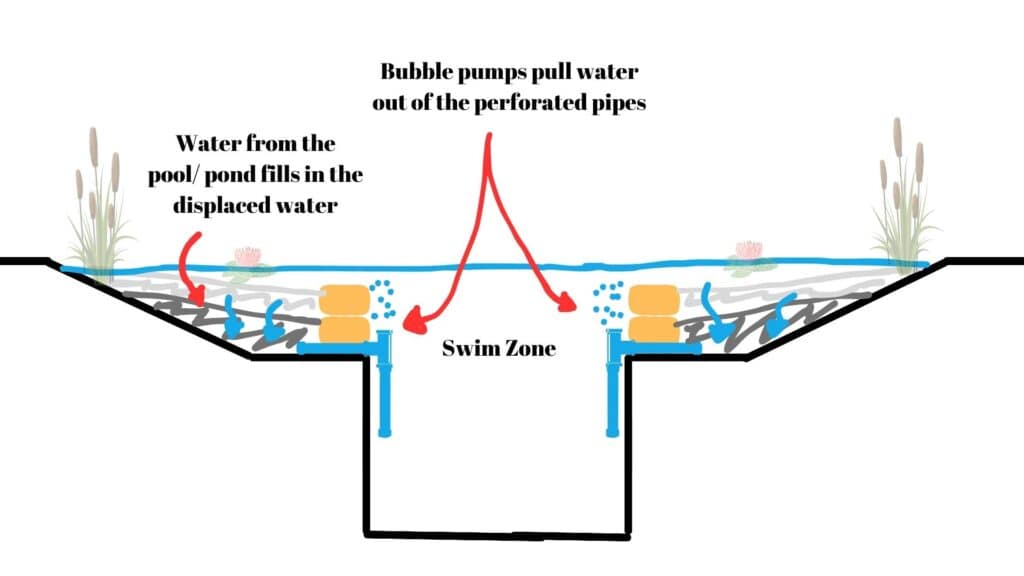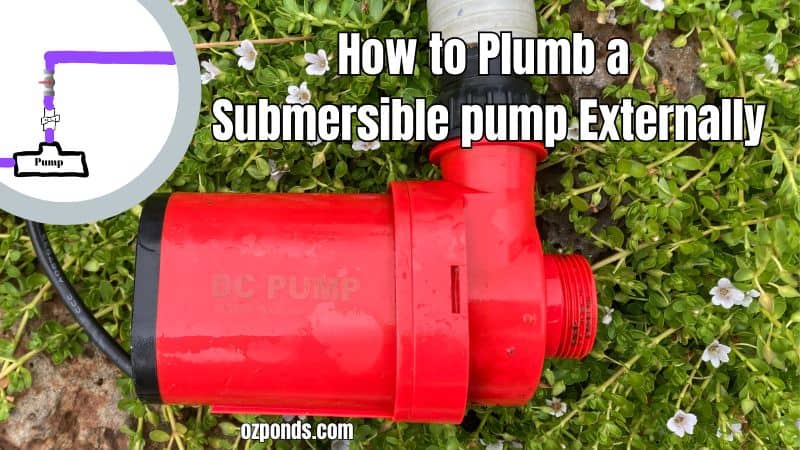When building a pond intended for swimming, one of the key requirements is keeping all electrical components safely out of the water. This is crucial since water and electricity don’t mix.
In this article I want to talk about some of the options for water circulation and how you can use an efficient submersible pump and set it up externally, so it’s not actually in the water.
So, if that is something that interests you, keep reading or check out the video (below) I made on the topic.
A popular solution for this is using bubble pumps, which utilize air to move water through the filtration zone.
While this method eliminates the need for electricity inside the pond, it has its limitations, particularly if you want to incorporate streams and waterfalls into your pond design.
Understanding the Limitations of Bubble Pumps
Bubble pumps are great for moving water without electricity in the pond, but they aren’t very effective when it comes to pumping water to any height or under pressure. This makes them less suitable for ponds that feature waterfalls or streams.
On the other hand, external pumps (Amazon link), like those used for traditional swimming pools, offer the ability to pump water with force and to greater heights. However, these pumps can be less efficient than submersible pumps, and they often come with a higher price tag and increased noise levels.

Safety First: Check Local Regulations
Before you start, it’s essential to be aware of the rules and regulations regarding swim ponds in your area.
These can vary depending on where you live, so reach out to your local building authority or government branch for written guidance. This will ensure that you’re compliant with all safety requirements, especially those concerning electricity and fencing.
I like to send them an email so I have the requirements in writing.
Why Use a Submersible Pump Externally?
Submersible pumps are efficient, cost-effective, and quieter compared to their external counterparts. The downside, however, is that their electrical components are usually submerged in water.
So let’s take a look at how you can safely install a submersible pump outside the pond and keep the electrical cords out of the water, while still benefiting from the pump’s efficiency.
Setting Up the Pump Externally
To install a submersible pump outside the pond, you’ll need to excavate a small area close to the pond. We need the pump positioned lower than the water level inside the pond, this ensures the pump always has access to water.
Here’s a step-by-step guide:
Excavate a Space for the Pump: Dig a small area near your pond, preferably close to the skimmer or intake bay.

A skimmer or intake bay is an area of the pond that water is pumped from. The pull of water into this area helps trap floating debris, they also provide a pre-filter to the pump, preventing large debris getting caught in the impeller and clogging the pump. They are a great addition to any pond.
If you to learn more about how to construct your own DIY skimmer for under $20, read this article. There’s also an accompanying video, showing how it is made. Or you might prefer to purchase a professional grade surface skimmer. (Amazon link).
I also have an article and accompanying videos on how to build and intake bay.

Use a Bulkhead Fitting: This fitting will allow you to run a plumbing line through the side of the pond liner or skimmer box, ensuring a watertight seal.
Install a Protective Manifold: Since you’ll need to remove the pump’s standard protective cage, it’s crucial to add a manifold that prevents large debris from entering the pump.
You can reuse the cage or create something with a larger surface area, such as a larger diameter pipe with multiple holes or a pipe covered with a coarse sponge.

Add Valves and Barrel Assemblies: Before the plumbing line enters the pump, install a valve (Amazon link)that allows you to shut off water flow.
Also, add a barrel assembly (Amazon link) that lets you remove the pump without cutting the plumbing line. This setup will make maintenance easier and prevent unnecessary water loss.

Ensure Proper Drainage and Covering: Keep the pump off the floor to avoid it being covered in dirt and mud. If possible, create a drainage system or ensure that the area slopes so that water drains away from the pump.
Covering the pump area will not only improve aesthetics but also help keep the pump cool. Submersible pumps have lower operation temperatures than external pumps.
Everything must be water tight:All the plumbing needs to be watertight to prevent lots of water loss inside the pond.
Option to Come up Over the Side of the Pond
If you’re concerned about potential leaks in the external plumbing, or worried about putting a hole in the liner, consider having the pipework come up and over the liner, creating a siphon system.
You will need to add a T-piece with screw cap to ensure the pipe is flooded. However, be cautious, as air bubbles can break the siphon, causing the pump to run dry.

Most submersible pumps come with dry run protection, meaning they’ll turn off if they detect a lack of water. However, they typically only turn off for a set period before trying to restart, so it’s important to monitor your system closely.
Conclusion
I hope this guide has been helpful for you! If you haven’t already, be sure to subscribe to my YouTube channel and mailing list for more pond tips and tricks!
Happy pond building!

